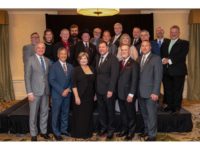The International Code Council members elected its 2014-2015 Board Officers and Directors during the group’s Annual Business Meeting at the 2014 Annual Conference in Fort Lauderdale, Fla.
Guy Tomberlin, chief of the residential/light commercial inspections branch of the Fairfax (Va.) County Department of Public Works and Environmental Services, was elected president of the board. Tomberlin has been active in code compliance since 1985.
Alex “Cash” Olszowy IIIwas voted in as vice president. He is a building inspection supervisor for the Lexington (Ky.) Fayette Urban County Government and has been with the department since 1997.
Georgia State Fire Marshal M. Dwayne Garriss was elected secretary/treasurer. His office oversees building inspections and engineering, manufactured housing inspections, hazardous materials inspections, elevators, boilers, pressure vessels and licensing throughout Georgia.
Jay Elbettar was reelected to a three-year term as a sectional director representing Alaska, California, Hawaii, Nevada, Oregon and Washington. Elbettar is a building official with Mission Viejo, Calif., and has been involved in code enforcement for more than 30 years.
Richard C. Truitt Sr., a deputy code director for Hartford County (Md.), was reelected to a three-year term as a sectional director representing Connecticut, Delaware, Maine, Maryland, Massachusetts, New Hampshire, New Jersey, New York, Pennsylvania, Rhode Island, Vermont, Virginia, West Virginia and Washington D.C.
For more information on elected officials, please visit www.iccsafe.org.
In other ICC news, the group and the American Society of Agricultural and Biological Engineers released a new ANSI consensus standard to classify sprinkler and drip irrigation systems, and set uniform testing procedures. Additionally, it will establish minimum design and performance requirements for commercial and residential landscape irrigation components.
The ASABE/ICC 802-2014 Landscape Irrigation Sprinkler and Emitter Standard represents collaboration among a range of industry stakeholders including manufacturers, the U.S. EPA the WaterSense program, the Irrigation Association, the Alliance for Water Efficiency and more.
The standard specifically defines and categorizes various types of devices including sprays, rotors, multi-stream/multi-trajectory nozzles, bubblers, drip emitters and microsprays. Other areas covered in the standard include:
• Burst pressure test procedures and minimum requirements;
• Distribution uniformity calculation methods based on various spacing types;
• Minimum requirements for integral pressure regulation;
• New test procedures for missing or damaged nozzles; and
• New provisions for the communication of product performance data.

